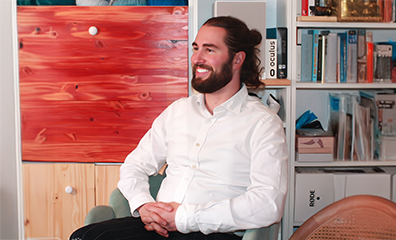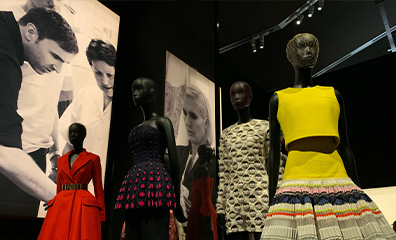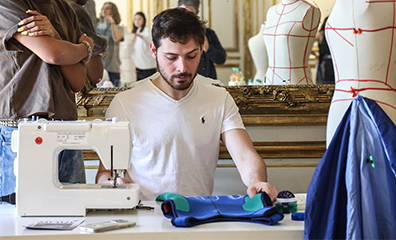Furoshiki – Sustainable Japanese Traditional Wrapping
Posted on 16/12/2021
Gift wrapping made of fabric has come a long way from its original country: furoshiki, an ancestral Japanese technique, is taking Europe by storm! From eco-friendly samurai to DIY, how did this fabric succeed in supplanting single-use packaging?
An eco-responsible container, it is a real alternative to reduce waste. Fold, tie, wrap, and recycle your gift wrap? At IFA Paris, we love this virtuous, playful, zero waste, stylish design that also encourages everyone's creativity: in short, we're definitely a fan!
The Origins of Furoshiki
Its origins date back to the 8th century, when the Japanese nobility already used it to protect and pack their precious goods. The wrapping method will be democratized during the following centuries and extended to the upper classes. Clothes were wrapped in it when traveling while many merchants saw it as a practical way to transport their goods.
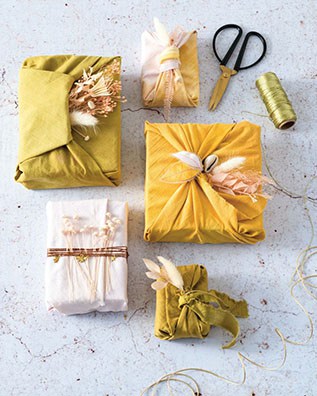
DIY Furoshiki Gift Wrapping - Source Feminin Bio
But it was not until the Edo era in the 17th century that the contemporary term "furoshiki" took on its full meaning. The Japanese term literally translates as bath (furo) spread (shiki), or "bathmat". At the time, bathrooms were almost non-existent in homes, so the use of public baths (sentos) was at its peak. Everybody goes there, provided with a square of fabric which accommodates all their personal effects. Each furoshiki was easily identifiable by its owner thanks to distinctive signs, personalized patterns or embroideries with the effigy of the family coat of arms.
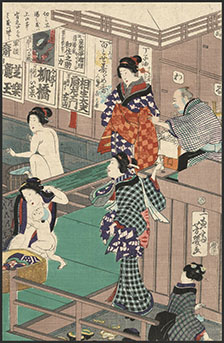
Furoshiki 17th Century Traditional Bath - Source Waste4Change
Evolution of the use of Furoshiki: from bath mat to gift wrap
At the end of World War II, Japan, like the rest of the world, gave in to the evil siren call of "Plastic Fantastic"! In the era of disposable products, the overconsumption of plastic bags unfortunately eclipsed any tradition, however old it may be. It is only in the early 2000s, with the awakening of ecological awareness and renewed interest in sustainable development, that the furoshiki will take its revenge. Adorned with its 3Rs costume (reduce, reuse, recycle), it became trendy again, including in France, where the law on energy transition now prohibits single-use packaging.
While in Japan the anti-waste culture (Mottainai) is in full swing, in France the attraction for the traditional method of furoshiki is also closely linked to the craze for creative hobbies or DIY. Making your own gift wrapping or creating an original container has become a real passion in France.
If the operation seems simplistic, folding and tying a square of fabric requires a certain skill, not exempt from learning the specific codes of furoshiki. The simple piece of fabric, although superficial in appearance, conceals a true ancestral culture. This thousand-year-old art, close to textile origami, carries a non-verbal communication quite complex to decipher for a non-initiated person. Depending on the personality of the individual, the occasion, the season, the size, or the shape of the object to be wrapped, the materials, colors, patterns, folds or knots will differ. The most sophisticated folds require a real know-how, and for good reason! Even if there are only 3 basic methods, the Hirazutsumi ("flat wrapping"), the Hitotsumusubi ("with one knot") or the Futatsumusubi ("with two knots"), more than 30 versions are listed...enough to occupy a few rainy weekends, right?
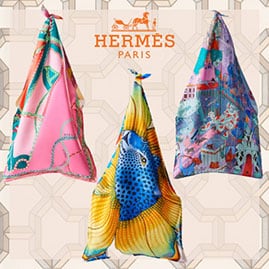
Furoshiki Hermes
Furoshiki, a militant act in favor of sustainable development
As an ecological alternative to wrapping paper, furoshiki allows you to extend the life of your tissue wrapping by reusing it either as new gift wrapping or by using upcycling techniques. It can easily be transformed into an everyday object, depending on the degree of dexterity and ingenuity of each person. (The less skilled can always follow the Upcycling Fashion short course offered by IFA Paris) Depending on its size and material, the square of fabric will become a scarf, a bee wrap, a card bag, a bracelet, a wipe, a cushion cover, or a sublime patchwork creation assembled with other miscellaneous fabrics.
In line with its commitment to sustainability, and to celebrate the 40th anniversary of its Paris campus and the 20th anniversary of its Shanghai campus, IFA Paris will publish a coffee table book in early 2022, which will be delivered in an exclusive packaging following the Furoshiki trend. The book, as well as the scarf that will wrap it, will be exclusive designs and limited to 100 pieces.
